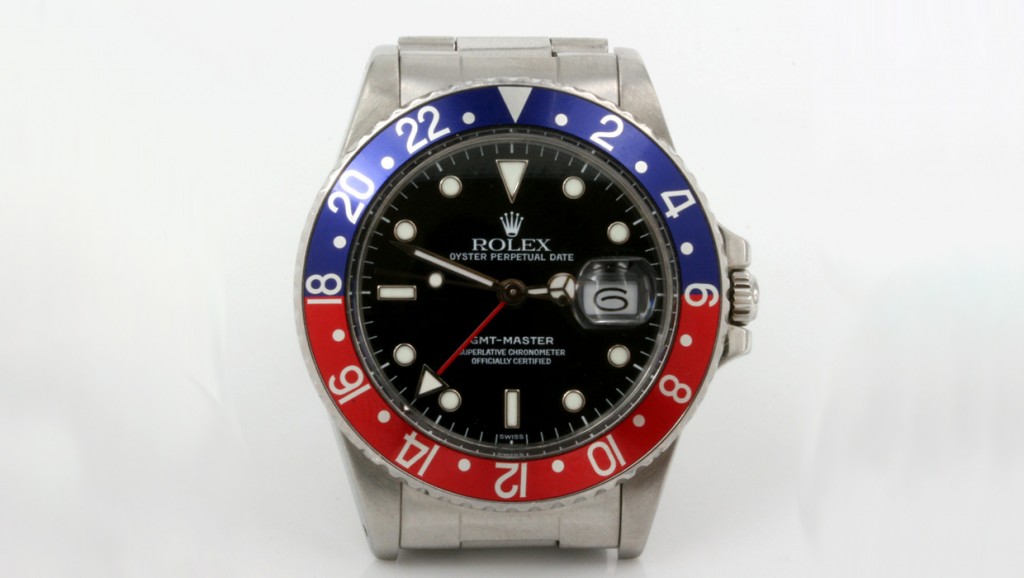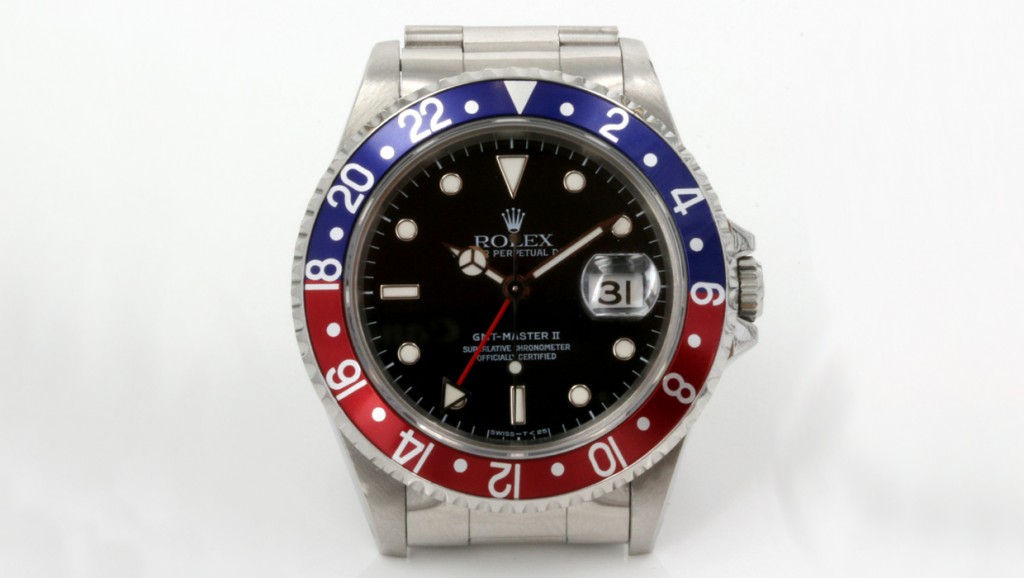[In 1954, Rolex launched a brand new watch targeted at the ‘Jet Set’ – those fortunate trend setters who were regular flyers and needed to be able to tell the time in two time zones at once. With the use of a fourth ‘GMT’ hand that could be read against 24-hour markers on a rotating bezel, Rolex made the task both simple and stylish.
Over the years Rolex have produced several versions of the GMT Master, the best known of which have nicknames for their bezel insert colour scheme taken from the names of fizzy drinks – ‘Pepsi’ (bright red and blue), ‘Coke’ (dark red and black) and ‘Root Beer’ (brown and gold).
Other colours have also been available including black, the extremely rare navy blue military issue from the mid 1960’s and more recently the blue and black (Batman) ceramic insert.
However, when all is said and done, the classic GMT Master for most people has always been and will always be the red and blue ‘Pepsi’ insert.
Released in 1954, the original GMT Master was the model No 6542 which featured a Pepsi bezel insert made from the all-new wonder material, Bakelite. Unfortunately bakelite developed a tendency to crack and so was replaced by an aluminium bezel insert in 1956.
As if you needed more evidence that Rolex fans like to use nicknames, the 6542 is sometimes called the ‘Pussy Galore’ after Honor Blackman wore one in the James Bond film ‘Goldfinger’ in 1964.
As a matter of interest, you may not be aware that rarest of all sports Rolex are the 200 white dialled 6542 GMT Masters that were made especially for Pan Am executives in the late 1950’s…although I’ve never spoken to anyone who has actually seen one.
The longest standing and best known model of vintage GMT Master is the 1675 which was introduced in 1959 and produced all the way through until 1980. Although the black bezel insert was introduced in 1972, it is the Pepsi insert that is best known on the 1675 and also on its later replacements, the 16750 and 16700.
When the 16760 GMT Master II ‘Sofia Loren’ was released in 1984 it was only available with the black & red ‘Coke’ bezel insert. Presumably Rolex’ intention was to be able to differentiate between the GMT Master and GMT Master II as one had a Pepsi insert and the other a Coke insert.
The Rolex buying public have always liked the Pepsi bezel though and they were considered in 1989 when a change in the GMT Master II line up saw the release of the new 16710. This model was immediately available with the Pepsi bezel insert again – an option which continued until the model was discontinued in 2007.
2007 brought ‘The ceramic revolution’ with the release of the ceramic bezelled 116710 GMT Master II. This all new watch was only available with solid coloured bezel inserts in either black or green – it seems that while ceramic bezel inserts are hard wearing and attractive, their original manufacturing process didn’t allow for a split colour bezel.
In order to continue to produce a Pepsi GMT, Rolex’ answer was to inset rubies and sapphires into the bezel of the 116710 – as you can see from the attached photos, the resulting effect is quite different to any preceding models and perhaps not to everyone’s taste. Oh and there’s also the obvious issue of the cost, a topic which we will return to shortly.
The great news for lovers of the Pepsi GMT is that this year Rolex have solved the production problem connected with bi coloured ceramic bezels and have released the GMT Master II Pepsi again – there’s a photo of this stunning watch at the top of the page. The only thing is that it’s only been produced in white gold and this brings a very hefty price tag.
As a self confessed and committed Rolex lover, I find myself occasionally baffled by some of the decisions made by the company. The amount of time that it has taken, and is still taking, to produce a classic stainless steel GMT Master II with a Pepsi bezel insert is one of those occasions.
One result of these delays is that vintage and mid-vintage Pepsi GMT’s look both highly attractive and excellent value. With the 2014 model currently retailing at around £22,000 and no stainless steel version on the horizon, £4,000 – £6,000 for a classic vintage model looks like a bargain to me – especially for an appreciating asset.
Since writing this my friend Arthur Touchot has reviewed the new GMT Master II Pepsi for Haute Time magazine and you can read his review here:
Many thanks to GMTMasterhistory.com for the jewelled GMT photo










